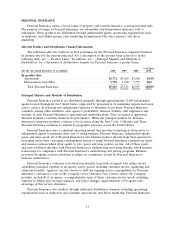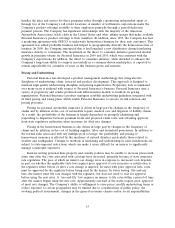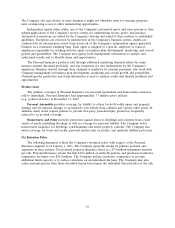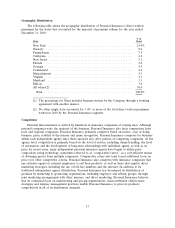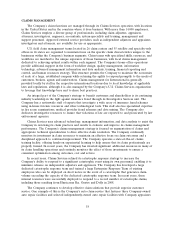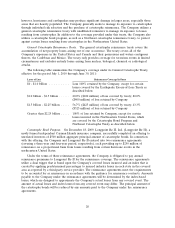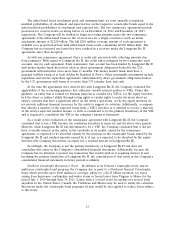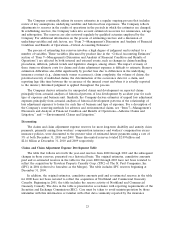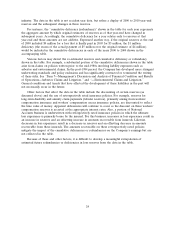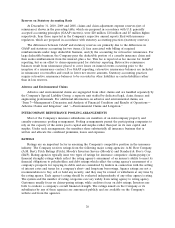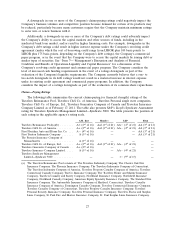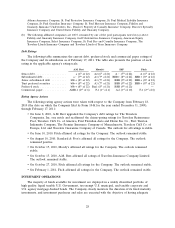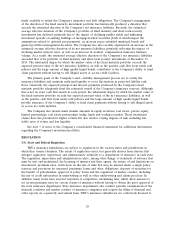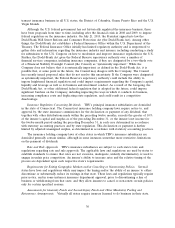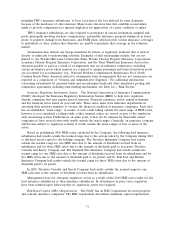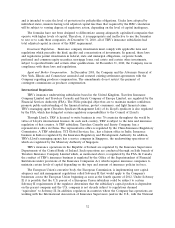Travelers 2010 Annual Report Download - page 35
Download and view the complete annual report
Please find page 35 of the 2010 Travelers annual report below. You can navigate through the pages in the report by either clicking on the pages listed below, or by using the keyword search tool below to find specific information within the annual report.The Company continually refines its reserve estimates in a regular ongoing process that includes
review of key assumptions, underlying variables and historical loss experience. The Company reflects
adjustments to reserves in the results of operations in the periods in which the estimates are changed.
In establishing reserves, the Company takes into account estimated recoveries for reinsurance, salvage
and subrogation. The reserves are also reviewed regularly by qualified actuaries employed by the
Company. For additional information on the process of estimating reserves and a discussion of
underlying variables and risk factors, see ‘‘Item 7—Management’s Discussion and Analysis of Financial
Condition and Results of Operations—Critical Accounting Estimates.’’
The process of estimating loss reserves involves a high degree of judgment and is subject to a
number of variables. These variables (discussed by product line in the ‘‘Critical Accounting Estimates’’
section of ‘‘Item 7—Management’s Discussion and Analysis of Financial Condition and Results of
Operations’’) are affected by both internal and external events, such as changes in claims handling
procedures, inflation, judicial trends and legislative changes, among others. The impact of many of
these items on ultimate costs for claims and claim adjustment expenses is difficult to estimate. Reserve
estimation difficulties also differ significantly by product line due to differences in the underlying
insurance contract (e.g., claims-made versus occurrence), claim complexity, the volume of claims, the
potential severity of individual claims, the determination of the occurrence date for a claim, and
reporting lags (the time between the occurrence of the insured event and when it is actually reported
to the insurer). Informed judgment is applied throughout the process.
The Company derives estimates for unreported claims and development on reported claims
principally from actuarial analyses of historical patterns of loss development by accident year for each
type of exposure and business unit. Similarly, the Company derives estimates of unpaid loss adjustment
expenses principally from actuarial analyses of historical development patterns of the relationship of
loss adjustment expenses to losses for each line of business and type of exposure. For a description of
the Company’s reserving methods for asbestos and environmental claims, see ‘‘Item 7—Management’s
Discussion and Analysis of Financial Condition and Results of Operations—Asbestos Claims and
Litigation,’’ and ‘‘—Environmental Claims and Litigation.’’
Discounting
The claims and claim adjustment expense reserves for most long-term disability and annuity claim
payments, primarily arising from workers’ compensation insurance and workers’ compensation excess
insurance policies, were discounted to the present value of estimated future payments using a rate of
5% at both December 31, 2010 and 2009. These discounted reserves totaled $2.09 billion and
$2.16 billion at December 31, 2010 and 2009 respectively.
Claims and Claim Adjustment Expense Development Table
The table that follows sets forth the year-end reserves from 2000 through 2010 and the subsequent
changes in those reserves, presented on a historical basis. The original estimates, cumulative amounts
paid and re-estimated reserves in the table for the years 2000 through 2003 have not been restated to
reflect the acquisition by Travelers Property Casualty Corp. (TPC) of The St. Paul Companies, Inc.
(SPC) in 2004 (referred to hereafter as the Merger). The table includes SPC reserves beginning at
December 31, 2004.
In addition, the original estimates, cumulative amounts paid and re-estimated reserves in the table
for 2000 have not been restated to reflect the acquisition of Northland and Commercial Guaranty
Casualty. Beginning in 2001, the table includes the reserve activity of Northland and Commercial
Guaranty Casualty. The data in the table is presented in accordance with reporting requirements of the
Securities and Exchange Commission (SEC). Care must be taken to avoid misinterpretation by those
unfamiliar with this information or familiar with other data commonly reported by the insurance
23



